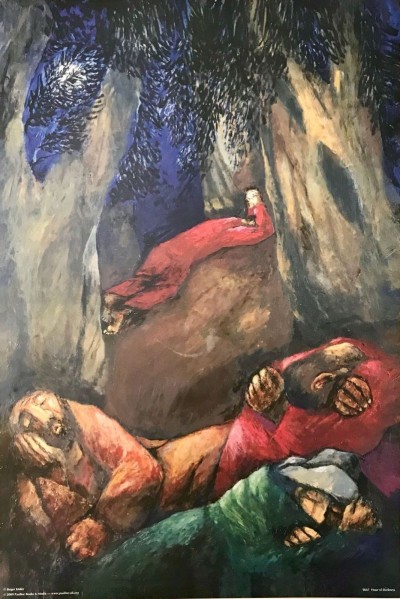
Already in the midst of Holy Week, tonight we begin the Triduum with the celebration of Holy Thursday, the Evening Mass of the Lord’s Supper. There are many ways to approach Holy Week and the Triduum. One of them is considering the different locations, or scenarios in which the Passion takes place. We read the text of the Passion twice during Holy Week: We read the synoptic version on Palm Sunday (Mark, Matthew and Luke) following the annual cycles of the Lectionary (this year we are reading Mark) and John’s version, which we read every year on Good Friday.
The locations of the Passion take us from the entrance of Jerusalem to Jesus’ tomb, going through the house of Simon the leper, the Upper Room, the garden of Gethsemane, the residence of the High Priest, Pilate’s palace and Golgotha. All these places are important, but Gethsemane continues being the place that moves me the most—the place that, in my opinion, gives more meaning to the experience of the Passion.
Following Mark’s account, after the Passover meal, Jesus and his disciples head to Gethsemane. On the way there, Jesus tells his disciples that they are going to abandon him, announces his Resurrection once again, and predicts Peter’s denial. Upon arriving to the garden of Gethsemane, Jesus displays his full humanity. It is in the garden that we witness Jesus’ struggle. Despite being the Son of God, he suffers like a human. We dare to think that Jesus is not suffering so much in anticipation of the physical pain that he is going to endure on the next day; it is a deeper pain, the emotional pain of giving up a full life, of abandoning those he loved. We cannot strip away Jesus’ humanity, we cannot remove Gethsemane from the way to the Cross. The absolute surrender of Jesus to God’s plan makes sense only if we see how Jesus overcomes, once again, the temptation not to be the Beloved Son of God.
To comprehend this last temptation of Christ, we are reminded that after the celebration of Ash Wednesday, we always begin the journey of Lent on the First Sunday with the text of the Temptations. We read Mark’s this year, where the Temptations only take two verses (Mk 1:12-13.) Luke’s is the Gospel that most clearly indicates that, “When the devil had finished every temptation, he departed from him for a time,” (Lk 4:13) a subtle threat that the devil will come back at an auspicious time. And that moment is Gethsemane.
In Gethsemane, before being taken prisoner, Jesus states that he is dying of sorrow. In the garden of Gethsemane Jesus asks his disciples to pray so that they do not fall into temptation. In the garden the scene of the Transfiguration takes place again (as we see also in Matthew’s account.)
Jesus takes apart the same disciples that he took with him in the Transfiguration—Peter, James and John. Jesus then prays out loud to the Father, whom he addresses as “Abba,” begging him to take away that “cup” from him. He then immediately submits to the Father’s will. Just like in the Transfiguration, the disciples have fallen asleep. Jesus rebukes Peter—whom he calls Simon, he has lost his identity—and commands him not to fall into temptation.
What is the temptation that Jesus experienced? If we realize the parallel with the Transfiguration—which we always read on the Second Sunday in Lent, following the Temptations—if we see that Gethsemane is a parallel with the scene on top of Mount Tabor, we know that the temptation is that Jesus, in possession of his absolute freedom, would choose not to act like the Son of God he is, and would decide not to submit to the suffering of the Cross.
In the Transfiguration, the voice of God tells Jesus’s disciples, “This is my Son, the Beloved.” It is a confirmation of Jesus’ identity that is connected to his baptism, when the same voice proclaims the same message in a baptism that, as Jesus is free from sin, could only be of identity. Thus, this is Gethsemane: a new, last temptation of identity (as all the Temptations really were about!) The Son of Man overcomes in an instant the temptation of not being who he is by not submitting to the Cross.
Holy Thursday accounts and recreates this experience in the Adoration that follows the celebration of the Eucharist. From the end of Mass until at least midnight, we prostrate ourselves before the real presence of Jesus, who has been tossed about for an instant between his love for life and his people and his love for his Father. In Gethsemane, Jesus realizes that both are the same love. It is the Jesus that for an instant begs the Father to strip him from his identity. It is in overcoming this last temptation that fills with meaning and profound love the decision to submit to the Cross.
It is Gethsemane that brings us closer to the human Jesus, human like us, tempted but firm, who suffers, but who loves like we are called to love. It is in Gethsemane that we are shown what we are capable of becoming—of being!—when we feel like children profoundly beloved by the Father.
It is with Gethsemane at heart that we approach and understand the Cross, the absolute submission to the love of God and love of neighbor. With Gethsemane at heart we understand the beauty of the Resurrection that awaits us on the other side of Passover.
May you have a blessed Holy Week.









